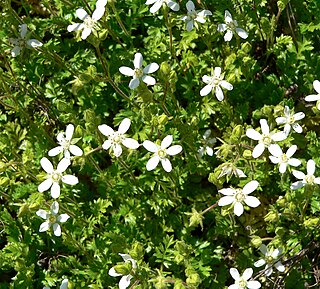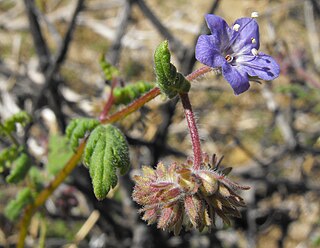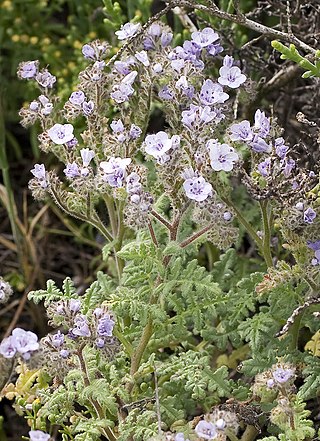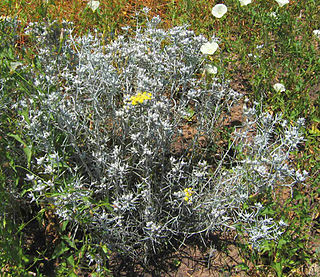
Nolina cismontana, the chaparral beargrass, chaparral nolina, California beargrass, Peninsular beargrass, or peninsular nolina, is a rare species of flowering plant of the Peninsular and Transverse Ranges in California. It is endemic to only four counties in Southern California: Los Angeles, Orange, San Diego and Ventura Counties. There are perhaps 15 to 17 occurrences in existence, with a total population estimated between 10,000 and 20,000.

Phacelia minor, with the common names Whitlavia and wild Canterbury bells, is a species of phacelia. It is native to Southern California and Baja California, where it grows in the Colorado Desert and the coastal and inland mountains of the Transverse-Peninsular Ranges, often in chaparral and areas recently burned.

Potentilla parryi, commonly known as Parry's horkelia, is a species of flowering plant in the rose family. It is endemic to California, where it grows in the chaparral of the Sierra Nevada foothills.

Arctostaphylos glauca is a species of manzanita known by the common name bigberry manzanita. It is native to California and Baja California, where it grows in the chaparral and woodland of coastal and inland hills.

Leptosiphon grandiflorus is a species of flowering plant in the phlox family known by the common names large-flower linanthus and large flowered leptosiphon.

Phacelia breweri is a species of phacelia known by the common name Brewer's phacelia.

Phacelia californica is a species of phacelia known by the common names California phacelia and California scorpionweed. It is native to coastal northern California and Oregon, where it grows in chaparral, woodland, and coastal bluffs and grassland.

Phacelia davidsonii is a species of phacelia known by the English name Davidson's phacelia named by Asa Gray for the discoverer of this annual plant, Anstruther Davidson, a Scottish naturalist who emigrated from Scotland to Los Angeles, California, in the late nineteenth century. This native forb occurs in southern California and southern Nevada, where it grows in mountains and foothills in chaparral and woodland habitats. In California, this herb is found in the Southern Sierra Nevada, Transverse Ranges, and Peninsular Ranges.

Phacelia distans is a species of flowering plant in the borage family, Boraginaceae, known by the common names distant phacelia and distant scorpionweed. It is native to the southwestern United States and northwestern Mexico, where it grows in many types of habitat, including forest, woodland, chaparral, grassland, and meadows.

Phacelia divaricata is a species of phacelia known by the common name divaricate phacelia. It is endemic to California, where it grows in the coastal hills and mountain ranges around the San Francisco Bay Area and to the north. It grows in chaparral, woodland, grassland, and other local habitat.

Phacelia floribunda is a species of phacelia known by the common names many-flowered phacelia, southern island phacelia and San Clemente Island phacelia. It is known only from San Clemente Island, one of the Channel Islands of California, and Guadalupe Island off the coast of Baja California. It grows in coastal sage scrub habitat in the canyons of these two islands.

Phacelia grandiflora is a species of phacelia known by the common name largeflower phacelia. It is native to the coastal hills and southern Transverse Ranges of southern California and Baja California, where it grows in coastal sage scrub, chaparral, and other local habitat, including areas recently burned by wildfire.

Phacelia grisea is a species of phacelia known by the common name Santa Lucia phacelia. It is endemic to California, where it can be found in the Santa Lucia Range and western sections of the Transverse Ranges.
Phacelia longipes is a species of phacelia known by the common name longstalk phacelia. It is endemic to California, where it grows in the Transverse Ranges and adjacent western Mojave Desert. Its habitat includes chaparral, woodland, and forest, in rocky soils.
Phacelia phacelioides, the Mt. Diablo phacelia, is a species of phacelia. It is endemic to California, where it is known from about 20 occurrences in the coastal mountain ranges of the inner San Francisco Bay Area, including Mount Diablo. It is a resident of chaparral and woodland habitat.

Phacelia stellaris is a rare species of flowering plant in the borage family, Boraginaceae, known by the common names star phacelia and Brand's phacelia.
Phacelia vallicola is a species of phacelia known by the common name mariposa phacelia. It is endemic to California, where it is known only from the Sierra Nevada and adjacent southernmost slopes of the Cascade Range. It grows in coniferous forest, chaparral, and other mountain and foothill habitat.

Phacelia viscida is a species of phacelia known by the common names sticky phacelia and tacky phacelia.

Ribes indecorum is a species of currant known by the common names white-flowered currant and white chaparral currant. It is native to the southern California Coast Ranges, Transverse Ranges, and Peninsular Ranges, from around Santa Barbara County in California south into northern Baja California.

Tetradymia comosa is a species of flowering plant in the aster family, known by the common name hairy horsebrush.

















